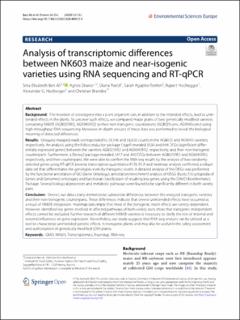| dc.description.abstract | Background The insertion of a transgene into a plant organism can, in addition to the intended effects, lead to unintended effects in the plants. To uncover such effects, we compared maize grains of two genetically modified varieties containing NK603 (AG8025RR2, AG9045RR2) to their non-transgenic counterparts (AG8025conv, AG9045conv) using high-throughput RNA sequencing. Moreover, in-depth analysis of these data was performed to reveal the biological meaning of detected differences. Results Uniquely mapped reads corresponded to 29,146 and 33,420 counts in the AG8025 and AG9045 varieties, respectively. An analysis using the R-Bioconductor package EdgeR revealed 3534 and 694 DEGs (significant differentially expressed genes) between the varieties AG8025RR2 and AG9045RR2, respectively, and their non-transgenic counterparts. Furthermore, a Deseq2 package revealed 2477 and 440 DEGs between AG8025RR2 and AG9045RR2, respectively, and their counterparts. We were able to confirm the RNA-seq results by the analysis of two randomly selected genes using RT-qPCR (reverse transcription quantitative PCR). PCA and heatmap analysis confirmed a robust data set that differentiates the genotypes even by transgenic event. A detailed analysis of the DEGs was performed by the functional annotation of GO (Gene Ontology), annotation/enrichment analysis of KEGG (Kyoto Encyclopedia of Genes and Genomes) ontologies and functional classification of resulting key genes using the DAVID Bioinformatics Package. Several biological processes and metabolic pathways were found to be significantly different in both variety pairs. Conclusion Overall, our data clearly demonstrate substantial differences between the analyzed transgenic varieties and their non-transgenic counterparts. These differences indicate that several unintended effects have occurred as a result of NK603 integration. Heatmap data imply that most of the transgenic insert effects are variety-dependent. However, identified key genes involved in affected pathways of both variety pairs show that transgenic independent effects cannot be excluded. Further research of different NK603 varieties is necessary to clarify the role of internal and external influences on gene expression. Nevertheless, our study suggests that RNA-seq analysis can be utilized as a tool to characterize unintended genetic effects in transgenic plants and may also be useful in the safety assessment and authorization of genetically modified (GM) plants. | en_US |

